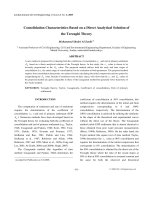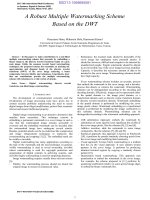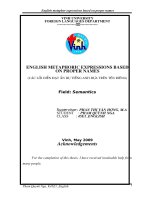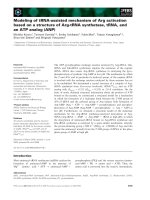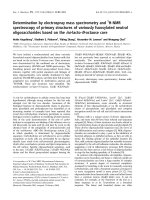PLASMONICS NANOFOCUSING BASED ON LONGRANGE SURFACE PLASMON POLARITONS
Bạn đang xem bản rút gọn của tài liệu. Xem và tải ngay bản đầy đủ của tài liệu tại đây (1.86 MB, 79 trang )
HANOI UNIVERSITY OF SCIENCE AND TECHNOLOGY
SCHOOL OF ELECTRONICS AND
TELECOMMUNICATIONS
GRADUATE THESIS
TOPIC:
PLASMONICS NANOFOCUSING BASED ON
LONGRANGE SURFACE PLASMON
POLARITONS
Student: NGUYỄN NGỌC AN
Class No.8 – K51
Supervisor: Professor ĐÀO NGỌC CHIẾN, Ph.D
Hanoi, May 2011
5/2011 Plasmonics nanofocusing based on longrange surface plasmon polaritons
NGUYỄN NGỌC AN
Class No. 8 - K51
HANOI UNIVERSITY OF SCIENCE AND TECHNOLOGY
SCHOOL OF ELECTRONICS AND
TELECOMMUNICATIONS
GRADUATE THESIS
TOPIC:
PLASMONICS NANOFOCUSING BASED ON
LONGRANGE SURFACE PLASMON
POLARITONS
Student: NGUYỄN NGỌC AN
Class No.8 – K51
Supervisor: Professor ĐÀO NGỌC CHIẾN, Ph.D
Hanoi, May 2011
PURPOSE OF GRADUATE THESIS
Student‟s name: .…………….………….…… Student‟s ID: ………………
Key: …………………….School of Electronics and Telecommunications
Department: ………………
1. Thesis title:
……………………………………………… ………………………………………………
………………………………………………………………………………………………
2. Initial data:
…………………………………… …………………………………………… …… ……
………………………………………………………………………………………………
……………………………………………………….… ……………………… …………
3. Contents of explanation and calculation:
………………………………………………………………………………………………
……………… ….…………………………………………………………………………
………………………………………………………… ….………………………………
………………………………………………………………………………………………
Figures and graphs (detail types and size of graphs)
………………………………………………………………………………………………
……………………… ….…………………………………………………………………
……………………………………………………… ……….……………………………
4. Academic supervisor’s name: ……………………………………………………… …
5. Thesis starting date: ………………………………………………….……………
6. Thesis finishing date: …………………………………………………………… …
June ……,2011
Department Chair
Academic Supervisor
This acknowledges that this student has completed and submitted this graduate
thesis in May……, 2011
Judge
MINISTRY OF EDUCATION AND
TRAINING
SOCIALIST REPUBLIC OF VIETNAM
HANOI UNIVERSITY OF SCIENCE AND
TECHNOLOGY
Independence – Freedom - Happiness
MINISTRY OF EDUCAITON AND TRAINING
HANOI UNIVERSITY OF SCIENCE AND TECHNOLOGY
GRADUATE THESIS REVIEW
Student‟s name: Student‟s ID:
Department: Key:
Academic supervisor:
Judge:
1. Contents of graduate thesis:
2. Review of judge:
May , 2011
Judge
( Signature, detailed fullname )
1
Preface
The research presented in this thesis aims to discover the responses of gold to the
excitation in a proposed waveguide structure based on a phenomenon excavated in
the time of the Holy Roman Empire. It is also the result of intensive efforts to create
a potential application for those properties on the current developing field of
nanometric optics.
This thesis has been completed in one year after I came to the Computational
Electromagnetic R&D Laboratory. By that time, I have worked with a number of
great people who contributed in many ways to the research. I would like to thank all
of them for helping and inspiring me during my graduate study.
At the first place, I especially want to thank my supervisor, Prof. Dao Ngoc Chien,
for his essential guidance and endless encouragements during my research and study
at Hanoi University of Science and Technology. His perpetual energy and
enthusiasm in research had motivated all of his students, including me. In addition,
he was always accessible and willing to help his students with their research in
various ways. As a result, research life became smooth and rewarding for me.
I gratefully acknowledge Hoang Van Son for his advice and important supports
which made the research much easier. I would like to give him the deep thanks for
his kind consideration on me.
All my lab buddies at the Computational Electromagnetic R&D Laboratory made it
a convivial place to work. In particular, I would like to thank Quang Ngoc Hieu and
Nguyen Cong Anh for their constructive comments and helps. All other folks had
inspired me in research and life through our interactions during the long hours in the
lab.
Finally, my deepest gratitude goes to my family for their eternal love and support
throughout my life.
2
Abstract
In this research, I propose an excitation method for the convergence of long-
range surface plasmon polaritons at the tip of a 2D tapered waveguide in the near
infrared (λ
0
= 1550 nm). The waveguide structure comprises of three thin metal films
of finite width which are embedded in dielectrics in order to create both asymmetric
and symmetric metal slab waveguides which support long-range surface plasmon
polartitons (LRSPPs).
The 20 nm width Au film with complex permittivity ε
r,Au,20 nm
= -111.2558 - j17.46
and two different dielectrics, of which the refractive indices are n
1 =
1.453 and n
2
=
4 respectively, are used to implement the structure. Based on the end-fire coupling
technique with an incident plane wave source, long range surface plasmon polaritons
are excited and propagate along the thin Au films then converge drastically at the tip
of the tapered waveguide by constructive interferences causing an extreme field
enhancement. The simulation was implemented using finite difference time domain
method.
3
Table of Contents
Preface 1
Abstract 2
List of Figures 5
List of Symbols 7
List of Abbreviations 8
Introduction 9
Chapter 1 Basics of Surface Plasmon Polaritons 11
1.1 Maxwell‟s Equations 11
1.2 Surface Plasmon Polaritons at Metal-Insulator Interfaces 13
1.2.1 The Wave Equation of TM Mode and TE Mode 13
1.2.2 Surface Plasmon Polaritons at a Single Interface 17
1.2.3 Multilayer Systems and the Long Ranging Modes 19
1.3 Excitation Methods 23
1.3.1 Prism Coupling 23
1.3.2 Grating Coupling 25
1.3.3 End-fire Coupling Excitation 27
Chapter 2 Demand for nanofocusing, an idea and supporting results 29
2.1 The Increasing Demand of Nanofocusing and an Idea 29
2.2 Supporting Results 30
2.2.1 Extended Long Range Surface Plasmon Polaritons 30
2.2.2 Apertureless Nanotip 31
2.2.3 Plasmonic Nanofocusing Based on a Metal Coated Axicon Prism 32
Chapter 3 FDTD simulation 35
3.1 FDTD Simulation 35
3.2 Numerical Dispersion 41
3.3 Numerical Stability – The Courant-Friedrichs-Lewy Stability Criterion 42
4
3.4 Perfect Electric Conductors 43
3.5 Dielectric-Dielectric Interface 43
3.6 Terminating The Simulation Domain 46
Chapter 4 Waveguide structure, simulation results and discussions 53
4.1 Centre symmetric longrange plasmonics waveguide. 53
4.2 Asymmetric MDM waveguide for long-range surface wave excitation. 54
4.3 Combination of centre symmetric MDM and two side-asymmetric plasmonic waveguide. 56
4.4 Waveguide Structure 59
4.5 Simulation results 61
4.3 The Dependence of the Field Magnification Factor and the Beam Side on Parameters 67
Conclusion 71
References 72
5
List of Figures
Figure 1.1 Definition of a planar wave guide geometry 15
Figure 1.2 Geometry for SPP propagation at a single interface between a metal and a dielectric. 18
Figure 1.3 Geometry of a three-layer system consisting of a thin layer I 20
Figure 1.4 Dispersion relation of the coupled odd and even modes. 22
Figure 1.5 Prism coupling to SPPs using attenuated total internal reflection 24
Figure 1.6 Prism coupling and SPP dispersion. 24
Figure 1.7 Phase-matching of light to SPPs using a grating. 26
Figure 1.8 End-fire coupling technique for exciting SPPs. 27
Figure 2.1 Scheme of the analyzed apertureless SNOM probe [8]. 32
Figure 2.2 Schematic for the localization of photons by a metal-coated axicon prism [10] 33
Figure 2.3 Intensity distributions on a gold-coated axicon prism for radially polarized incident light
[10]. 34
Figure 3.1 Discretization of the model into cubes and the position of field. 37
Figure 3.2 Basic flows for implementation of Yee FDTD scheme. 38
Figure 3.3 The three-dimensional computational region for FDTD simulation. 41
Figure 3.4 An example with PEC on the top surface of Cube (i, j, k). 43
Figure 3.5 Four adjacent cubes with different permittivity and conductivity. 44
Figure 3.6 A closed loop C crossing four cubes with different permittivity and conductivity. 44
Figure 3.7 Boundary E field component between two layers of different dielectrics. 52
Figure 4.1 Centre symmetric waveguide structure 53
Figure 4.2 A 3D view of longrange surface plasmon polariton excited in a MDM structure. 54
Figure 4.3 A 2D view of longrange surface plasmon excited in a MDM structure. 54
Figure 4.4 An asymmetric plasmonic waveguide structure. 55
Figure 4.5 A 3D view of LRSPPs excitation in an asymmetric structure. 55
Figure 4.6 A 2D view of LRSPPs excitation in an asymmetric structure. 56
Figure 4.6 A combination of a symmetric structure with two asymmetric waveguides. 56
Figure 4.7 Electric field distribution at x-z plane 57
Figure 4.8 A 2D view of the electric field distribution at x-z plane 57
Figure 4.9a H
y
at the x-z plane. 58
Figure 4.9b Magnetic field distribution at x-z plane. 58
Figure 4.11 Schematic of the simulated model with an incident wavelength of 1550 nm. 59
Figure 4.12 Electric field distribution at x-z plane 61
6
Figure 4.12a
‟
A 3D view of the electric field distribution at x-z plane. 61
Figure 4.12b Electric field distribution at y-z plane 62
Figure 4.12c Poynting vector in z-direction. 63
Figure 4.12d Magnetic field profile of the guided LRSPPs mode. 63
Figure 4.12e Magnetic field distribution at the x-z plane. 64
Figure 4.12f A 3D view of H
y
. 64
Figure 4.12g Electric field (upper) and phase (lower) distribution at the end of the structure. 65
Figure 4.13 Distribution of electric field at 5nm far from the apex. 66
Figure 4.14 Electric field profiles of Ez and Ex components at the apex. 66
Figure 4.15 Dependence of magnification factor and beam side on the outer cladding thickness 67
Figure 4.16 Dependence of magnification factor and beam side on the exponential coefficient. 68
Figure 4.17 Dependence of magnification factor and beam side on the tip width. 69
Figure 4.18 Dependence of magnification factor and beam side on the central film thickness. 70
7
List of Symbols
Symbols
Explanation
Electric Field
Magnetic Field
Magnetic Flux Density
Dielectric Displacement
Current Density
J
ext
External Current Density
0
Excitation wavelength
ε
Dielectric Constant
μ
Relative Permeability
Charge Density
External Charge Density
Conductivity
χ
Dielectric Susceptibility
k
0
Wave vector
β
Propagation Constant
8
List of Abbreviations
Abbreviation
Original term
SPPs
Surface Plasmon Polaritons
LRSPPs
Long Range Surface Plasmon Polaritons
FDTD
Finite Difference Time Domain
BEM
Boundary Element Method
FEM
Finite Element Method
SNOMs
Scanning Near-Field Optical Microscopes
9
Introduction
Surface plasmon polaritons (SPPs) are tranverse magnetic polarized optical
surface waves that propagate along an interface between a dielectric and a
conductor and it exponentially decays in the perpendicular direction. These
electromagnetic excitations are excited by coupling of an incident electromagnetic
field to oscillations of the conductor‟s free electrons. In a metal slab comprised of a
sufficiently thin metal film embedded in dielectrics, bound SPPs modes at the upper
metal- dielectric interfaces couples to that of the lower one forming two bound
super-modes. One of these coupled modes has lower attenuation as the metal film
thickness is reduced. It is called long- range surface plasmon polaritons (LRSPPs).
In recent explosive progress in nanometric optics, the strong concentration of
optical energy, which has been based on the great localization of surface plasmon
waves in nanostructures, provides people with a great ability to manipulate
substance at nanoscale. It was proposed that smoothly tapered metal plasmonic
waveguides focused light energy at its tip due to resonant properties of metal
nanoparticles [9-22]. Furthermore, conical dielectric waveguide structures with
metal-coating have asserted their ability in nanofocusing with great field
enhancement and ultra-high energy confinement based on the constructive
interference of surface waves. And in most cases, a transverse magnetic radially
polarized optical wave was used due to surface plasmon polaritons excitation and
the convergence of photons at the tips of the structures.
Recently, some scientits have proposed an excitation method for the localization of
photons at the apex of a gold- coated axicon prism. An enhanced spot was
generated 5 nm below the apex with a magnification factor of 120 times and
confined within 35 nm for an incident wavelength of 632.8 nm. Even though the
results are quite impressed, that method consumes high excitation energy and
provides quite low field enhancement and large beam side.
This thesis proposes another tapered dielectric plasmonic waveguide structure for
10
the convergence of long-range surface plasmon polaritons at the tip of the
waveguide in the near infrared (λ
0
= 1550 nm). It requires low excitation energy but
provides with extreme high field enhancement and small beam side at 5 nm far
from the apex.
The research bases on the results of a number of computational simulations.
Currently, there are some methods to solve electromagnetic problems such as BEM,
FDTD. Because of the advantages in near field observation, FDTD is chose to
implement the simulations, with a tool named OptiFDTD. In this thesis, all the
simulations were executed at 2D level.
This thesis consists of 4 chapters, in which the first chapter indicates basic literature
of surface plasmon polaritons and methods of excitation. Whereas, chapter 2
illustrates demand for nanofocusing and shows some external results, which support
the final design. Next, chapter 3 shows some basic literature of finite difference
time domain method used in simulations. Finally, chapter 4 shows output data of
the simulation and discussions about these results.
11
Chapter 1
Basics of Surface Plasmon Polaritons
This chapter presents some principles of surface waves, especially long range
surface plasmon polaritons and excitation methods.
1.1 Maxwell’s Equations
It is widely known that for frequencies up to the visible part of the spectrum metals
are highly reflective and do not allow electromagnetic waves to propagate through
them. Metals have been employed as cladding layers for the construction of
waveguides and resonators for electromagnetic radiation at microwave and far-
infrared frequencies for a long time.
At low frequencies, the perfect conductor approximation of infinite or fixed finite
conductivity is valid for most purposes, because only a negligible fraction of the
impinging electromagnetic waves penetrates into the metal. At higher frequencies
towards the near-infrared and visible part of the spectrum, field penetration
increases remarkably, causing increased dissipation. Finally, at ultra violet
frequencies, metals express dielectric character and allow the propagation of
electromagnetic waves, albeit with varying degrees of attenuation depending on the
details of the electronic band structure. For noble metals such as gold or silver on
the other hand, transitions between electronic bands lead to strong absorption at
these frequencies.
The interaction of metals with electromagnetic field can be understood in a classical
way based on the macroscopic Maxwell equations [1]. Maxwell‟s equations of
macroscopic electromagnetism are taken in the following form:
12
× = +
,
(1.1a)
× =
,
(1.1b)
= ,
(1.1c)
= 0.
(1.1d)
These equations connect the four macroscopic fields D (the dielectric
displacement), E (the electric field), H (the magnetic field), and B (the magnetic
induction or magnetic flux density) with the external charge and current densities
ρ
ext
and J
ext
[1].
These macroscopic equations are not explained normally via dividing the total
charge and current densities ρ
tot
and J
tot
into free and bound sets, which is an
arbitrary division and can (especially in the case of metallic interfaces) confuse the
application of the boundary condition for the dielectric displacement. Instead, we
distinguish between external (ρ
ext
, J
ext
) and internal (ρ,J) charge and current
densities, so that in total ρ
tot
= ρ
ext
+ ρ and J
tot
= J
ext
+ J. The external set drives the
system, while the internal set responds to the external stimuli. The four macroscopic
fields are further linked via the polarization P and magne-tization M by
D = ε
0
E + P,
(1.2a)
=
1
0
,
(1.2b)
where ε
0
and μ
0
are the electric permittivity and magnetic permeability of vacuum,
respectively. Since only treat non magnetic media will be treated, we need not
consider a magnetic response represented by M, but can limit our description to
electric polarization effects. P describes the electric dipole moment per unit volume
inside the material, caused by the alignment of microscopic dipoles with the electric
field. It is related to the internal charge density via · = . Charge
conservation (· = /) further requires that the internal charge and current
densities are linked via
=
.
(1.3)
13
The strong advantage of this approach is that the macroscopic electric field includes
all polarization effects: in other words, both the external and the induced fields are
absorbed into it. This can be shown via inserting (1.2a) into (1.1c), leading to
. =
0
(1.4)
In a linear, isotropic and nonmagnetic media, one can define the constitutive
relations
D = ε
0
εE
(1.5a)
B = µ
0
µH
(1.5b)
ε is called the dielectric constant or relative permittivity and μ = 1 is the relative
permeability of the nonmagnetic medium. The linear relationship (1.5a) between D
and E is often also implicitly defined using the dielectric susceptibility χ which
describes the linear relationship between P and E via
P = ε
0
χE
(1.6)
Inserting (1.2a) and (1.6) into (1.5a) yields ε = 1 + χ. The last important constitutive
linear relationship needs to be mentioned is that between the internal current density
J and the electric field E, defined via the conductivity σ by
J = σ E
(1.7)
1.2 Surface Plasmon Polaritons at Metal-Insulator Interfaces
Surface plasmon polaritons are electromagnetic excitations propagating at the
interface between a dielectric and a conductor, evanescently confined in the
perpendicular direction. These electro-magnetic surface waves arise via the
coupling of the electromagnetic fields to oscillations of the conductor‟s electron
plasma. This section describes the fundamentals of surface plasmon polaritons both
at single, flat interfaces and in metal- dielectric multilayer structures.
1.2.1 The Wave Equation of TM Mode and TE Mode
In order to investigate the physical properties of surface plasmon polaritons (SPPs),
Maxwell‟s equations (1.1) needs to be applied to the flat interface between a
conductor and a dielectric. It is an advantage to cast the equations first in a general
14
form applicable to the guiding of electromagnetic waves, the wave equation. In the
absence of external charge and current densities, the curl equations (1.1c, 1.1d) can
be combined to yield
× × = µ
0
2
2
(1.8)
Using the identities ×× E ≡ (· E) −
2
E as well as · (εE) ≡ E ·ε + ε· E,
and remembering that due to the absence of external stimuli · D = 0, (1.8) can be
rewritten as
(
1
ε
. )
2
= µ
0
ε
0
ε
2
t
2
(1.9)
For negligible variation of the dielectric profile ε = ε(r) over distances on the order
of one optical wavelength, (1.9) simplifies to the central equation of
electromagnetic wave theory,
2
ε
c
2
2
t
2
= 0
(1.10)
Practically, this equation has to be solved separately in regions of constant ε, and
the obtained solutions have to be matched using appropriate boundary conditions.
To cast (1.10) in a form suitable for the description of confined propagating waves,
we proceed in two steps. First, we assume in all generality a harmonic time
dependence E(r,t) = E(r)e
−iωt
of the electric field. Inserted into (1.10), this yields
2
E+ k
0
2
εE = 0
(1.11)
where k
0
= ω/c is the wave vector of the propagating wave in vacuum. Equation
(1.11) is known as the Helmholtz equation.
Next, the propagation geometry need to be defined. We assume for simplicity a one-
dimensional problem. ε depends only on one spatial coordinate. Specifically, the
waves propagate along the x-direction of a Cartesian coordinate system, and show
no spatial variation in the perpendicular, in-plane y-direction (see Fig.2.1); therefore
ε = ε(z). Applied to electromagnetic surface problems, the plane z = 0 coincides
15
with the interface sustaining the propagating waves, which can now be described as
E(x,y,z) = E(z)e
iβx
.
Figure 1.1 Definition of a planar wave guide geometry. The waves propagate along the x-direction
in a cartesian coordinate system.
The complex parameter β = k
x
is called the propagation constant of the traveling
waves and corresponds to the component of the wave vector in the direction of
propagation. Inserting this expression into (1.11) yields the desired form of the
wave equation
2
( )
z
2
+ (
0
2
)= 0
(1.12)
Likewise, a similar equation exists for the magnetic field H.
Equation (1.12) is the beginning point for the general analysis of guided
electromagnetic modes in waveguides. In order to use the wave equation for
calculate the spatial field profile and dispersion of propagating waves, we now need
to find explicit expressions for the different field components of E and H. This can
be achieved in a direct way using the curl equations (1.1c, 1.1d).
For harmonic time dependence (/ = - iω), propagation along the x-direction
(/ =- iβ) and homogeneity in the y-direction (/ = 0), we arrive at the
following set of equations
16
= µ
0
(1.13a)
= µ0
(1.13b)
iβE
y
=iωµ
0
H
z
(1.13c)
= 0
(1.13d)
= 0
(1.13e)
iβH
y
= - iωε
0
εE
z
(1.13f)
It can easily be shown that this system allows two sets of self-consistent solutions
with different polarization properties of the propagating waves. The first set are the
transverse magnetic (TM or p) modes, where only the field components E
x
, E
z
and
H
y
are non zero, and the second set the transverse electric (TE or s) modes, with
only H
x
, H
z
and E
y
being non zero.
For TM modes, the system of governing equations (1.13) reduces to
= (0)
1
(1.14a)
E
z
= - β(ωε
0
ε)
-1
H
y
(1.14b)
and the wave equation for TM modes is
2
()
2
+ (k
0
2
2
)
= 0
(1.14c)
For TE modes the analogous set is
= (µ
0
)
1
(1.15a)
H
z
= β(ω µ
0
)
-1
E
y
(1.15b)
with the TE wave equation
2
()
2
+ (
0
2
2
)
= 0
(1.15c)
17
1.2.2 Surface Plasmon Polaritons at a Single Interface
The most simple geometry sustaining SPPs is that of a single, flat interface (Fig.1.2)
between a dielectric, non-absorbing half space (z> 0) with positive real dielectric
constant ε
2
and an adjacent conducting half space (z< 0) described via a dielectric
function ε
1
(ω). The requirement of metallic character implies that Re [ε
1
] < 0. For
metals this condition is fulfilled at frequencies below the bulk plasmon frequency
ω
p
.
Using the equation set (1.14) in both half spaces yields
H
y
(z) = A
2
e
iβx
e
-k
2
z
(1.16a)
E
x
(z)= iA
2
(ωε
0
ε
2
)
-1
k
2
e
iβx
e
-k
2
z
(1.16b)
E
z
(z)=- A
1
β(ωε
0
ε
2
)
-1
e
iβx
e
-k
2
z
(1.16c)
for z > 0 and
H
y
(z) = A
1
e
iβx
e
k
1
z
(1.17a)
E
x
(z)= -iA
1
(ωε
0
ε
1
)
-1
k
1
e
iβx
e
k
1
z
(1.17b)
E
z
(z)=- A
1
β(ωε
0
ε
1
)
-1
e
iβx
e
k
1
z
(1.17c)
for z < 0.
k
i
≡ k
z,i
(i = 1, 2) is the component of the wave vector perpendicular to the interface
in the two media. Its reciprocal value,
= 1/ |k
z
|, defines the evanescent decay
length of the fields perpendicular to the interface, which quantifies the confinement
of the wave.
Continuity of H
y
and ε
i
E
z
at the interface requires that A
1
= A
2
and
k
2
/k
1
= - ε
2
/ε
1
(1.18)
18
Figure 1.2 Geometry for SPP propagation at a single interface between a metal and a dielectric.
Note that with the convention of the signs in the exponents in (1.16, 1.17),
confinement to the surface demands Re [ε1] < 0 if ε2 > 0 – the surface waves exist
only at interfaces between materials with opposite signs of the real part of their
dielectric permittivity, i.e. between a conductor and an insulator. The expression for
H
y
further has to fulfill the wave equation (1.14c), yielding
k
1
2
= β
2
- k
0
2
ε
1
(1.19a)
k
2
2
= β
2
- k
0
2
ε
2
(1.19b)
Combining this and (1.18) we have the dispersion relation of SPPs propagating at
the interface between the two half spaces
=
0
1
2
1
+
2
(1.20)
This expression is valid for both real and complex ε
1
, i.e. for conductors without
and with attenuation. We now briefly analyze the possibility of TE surface modes.
Using (1.15), the respective expressions for the field components are
E
y
(z) = A
2
e
iβx
e
-k
2
z
(1.21a)
H
x
(z)= -iA
2
(ωµ
0
)
-1
k
2
e
iβx
e
-k
2
z
(1.21b)
H
z
(z)= A
2
β(ωµ
0
)
-1
e
iβx
e
-k
2
z
(1.21c)
for z > 0 and
E
y
(z) = A
1
e
iβx
e
k
1
z
(1.22a)
H
x
(z)= iA
1
(ωµ
0
)
-1
k
1
e
iβx
e
k
1
z
(1.22b)
H
z
(z)= A
1
β(ωµ
0
)
-1
e
iβx
e
k
1
z
(1.22c)
19
for z < 0. Continuity of Ey and Hx at the interface leads to the condition
A
1
(k
2
+k
1
)= 0
(1.23)
Since confinement to the surface requires Re [k
1
] > 0 and Re [k
2
] > 0, this condition
is only fulfilled if A
1
= 0, so that also A
2
= A
1
= 0.Thus, no surface modes exist for
TE polarization. Surface plasmon polaritons only exist for TM polarization.
1.2.3 Multilayer Systems and the Long Ranging Modes
Multilayer systems consist of alternating conducting and dielectric thin films. In
such a system, each single interface can sustain bound SPPs. When the separation
between adjacent interfaces is comparable to or smaller than the decay length z of
the interface mode, interactions between SPPs give rise to coupled modes. In order
to investigate the general properties of coupled SPPs, we will focus on two specific
three layer systems of the geometry illustrated in Fig.1.3: Firstly, a thin metallic
layer (I) sandwiched between two infinitely thick dielectric claddings (II, III), an
insulator/metal/insulator (IMI) hetero structure, and secondly a thin dielectric core
layer (I) sandwiched between two metallic claddings (II, III), a
metal/insulator/metal (MIM) hetero structure. Since we are here only interested in
the lowest- order bound modes, we start with a general description of TM modes
that are non-oscillatory in the z-direction normal to the interfaces using (1.14). For
z>a, the field components are
H
y
= Ae
iβx
e
-k
3
z
(1.24a)
E
x
= iA(ωε
0
ε
3
)
-1
k
3
e
iβx
e
-k
3
z
(1.24b)
E
z
=- A
β(ωε
0
ε
3
)
-1
e
iβx
e
-k
3
z
(1.24c)
While for z< −a we get
H
y
= Be
iβx
e
k
2
z
(1.25a)
E
x
= -iB(ωε
0
ε
2
)
-1
k
2
e
iβx
e
k
2
z
(1.25b)
E
z
=- B
β(ωε
0
ε
2
)
-1
e
iβx
e
k
2
z
(1.25c)
20
Figure 1.3 Geometry of a three-layer system consisting of a thin layer I
sandwiched between two infinite half spaces II and III.
Thus, we demand that the fields decay exponentially in the claddings (II) and (III).
Note that for simplicity as before we denote the component of the wave vector
perpendicular to the interfaces simply as k
i
≡ k
z,i
. In the core region −a<z<a, the
modes localized at the bottom and top interface couple, yielding
H
y
= Ce
iβx
e
k
1
z
+ De
iβx
e
-k
1
z
(1.26a)
E
x
= -iC(ωε
0
ε
1
)
-1
k
1
e
iβx
e
k
1
z
+ iC(ωε
0
ε
1
)
-1
k
1
e
iβx
e
-k
1
z
(1.26b)
E
z
= C
β(ωε
0
ε
1
)
-1
e
iβx
e
k
1
z
(1.26c)
The requirement of continuity of H
y
and E
x
leads to
A
3
= Ce
k
1
+ De
k
1
(1.27a)
A
3
3
3
=
C
1
1
e
k
1
+
D
1
1
e
k
1
(1.27b)
at z = a and
B
2
= Ce
k
1
+ De
k
1
(1.28a)
B
2
2
2
=
C
1
1
e
1
+
D
1
1
e
1
(1.28b)
at z = − a, a linear system of four coupled equations. H
y
further has to fulfill the
wave equation (1.14c) in the three distinct regions, via
2
=
2
0
2
(1.29)

